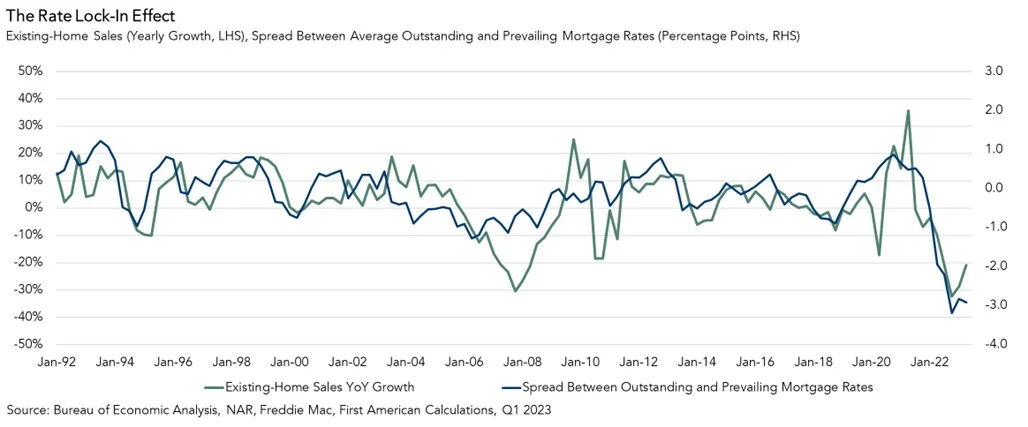 A new Housing Perspectives Blog post by Mark Fleming, the Chief Economist for First American Financial Corporation & the lead of First American’s Decision Sciences Team, focused on housing market potential and the lock-in effect.
A new Housing Perspectives Blog post by Mark Fleming, the Chief Economist for First American Financial Corporation & the lead of First American’s Decision Sciences Team, focused on housing market potential and the lock-in effect.
According to Fleming, First American’s Potential Home Sales Model increased by 1% in July, but remains 2% lower year-over-year. This marked the smallest decline since February 2022.
“The steep decline in sales driven by the rapid rise in mortgage rates seems to be behind us, as the initial shock of higher mortgage rates has worn off,” Fleming said. “While there was a modest monthly increase in market potential, existing-home sales will have a tough time gaining real momentum in a limited inventory environment where most homeowners are rate-locked into their homes – you can’t buy what’s not for sale.”
The main force impeding market potential is homeowners themselves, as they influence both the demand and supply side of the market. Historically, existing homes have made up nearly 90% of total sales and inventory. If existing homeowners don’t sell, there’s very little to buy. Further findings by First American revealed that over 90% of homeowners had mortgage rates under 6%, leaving many to make due with their current home instead of upgrading with a higher mortgage rate (which is hovering around 7.4%)—this is referred to as the lock-in effect.
“The strength of this rate lock-in effect can be estimated using the difference between the average rate for all outstanding mortgages and the prevailing market mortgage rate,” continued Fleming. “As the prevailing market mortgage rate rises further and further above the average rate for all outstanding mortgages, the greater number of existing homeowners are rate-locked in. Today, more than at any other point in the last 30 years, homeowners have very little financial incentive to sell their home.”
But on the other hand, life is unpredictable and the choice to move is more than just a financial equation. A homeowner may sell for lifestyle reasons, even if it means losing their pandemic-era mortgage rate. However, 42% of homeowners own the deed to their home and are not affected by the lock-in effect.
“Finally, homeowners have gained substantial equity in their homes as house prices soared over the course of the pandemic. For some of those equity-rich homeowners, moving and taking on a higher interest rate isn’t a huge deal, especially if they are moving to a more affordable place,” Fleming concluded. “For the remainder of 2023, existing-home sales may experience relative growth, particularly if mortgage rates fall, but it will be difficult to have a meaningful increase in sales without more existing-home inventory, even with these mitigating factors.”

By the numbers, First American’s report also revealed:
- Potential existing-home sales increased to a 5.36 million seasonally adjusted annualized rate (SAAR), a 1% month-over-month increase.
- This represents a 53.7% increase from the market potential low point reached in February 1993.
- The market potential for existing-home sales decreased 1.9% compared with a year ago, a loss of 102,116 (SAAR) sales.
- Currently, potential existing-home sales is 1,432,275 (SAAR), or 21.1%, below the peak of market potential, which occurred in April 2006.
Click here to see the blog post in its entirety.

 DSNews The homepage of the servicing industry
DSNews The homepage of the servicing industry








